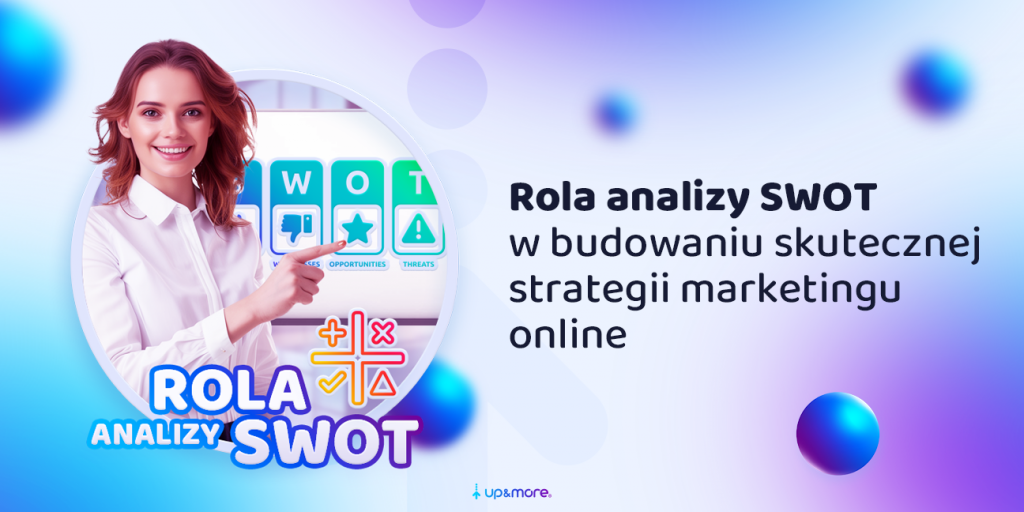Table of contents
Although SWOT analysis is widely used in marketing in the broadest sense, in an era of increasing dominance of digital communication and commerce channels, its use in the context of online marketing is becoming increasingly important.
Online marketing differs from traditional forms of marketing not only in its message channels, but also in its tools, techniques and speed of response to market and technological changes. Therefore, in order to compete effectively in the digital marketplace, companies need to adjust their marketing strategies, using SWOT analysis in a way that reflects the specifics and challenges of this environment.
The online marketing landscape is different from traditional marketing channels and forms of marketing.

Definition of SWOT analysis
SWOT analysis is a strategic tool used to assess four key aspects of your business: Strengths, Weaknesses, Opportunities and Threats. The analysis aims to get a holistic picture of your company’s situation, allowing you to identify internal and external factors that may affect your business. Strengths and weaknesses refer to a company’s internal characteristics, such as resources, skills, technologies or processes. Opportunities and threats, on the other hand, refer to external factors such as market trends, technological changes, regulations or competitors’ actions.
Frequency of SWOT analysis in online marketing
Nowadays, online marketing has become an integral part of business strategies. The Internet offers unprecedented opportunities to reach customers on a global scale, but at the same time, it poses new challenges for your company. In this context, SWOT analysis is extremely important for several reasons:
- Identifying Strengths: A SWOT analysis will help you identify your strengths and use them to maximize your online effectiveness.
- Identifying Weaknesses: With a SWOT analysis, you can identify areas for improvement and take corrective action.
- Taking advantage of opportunities: SWOT allows you to identify and capitalize on opportunities to grow and become more competitive.
- SWOT analysis.
- Managing threats: With SWOT analysis, your company can anticipate threats and prepare appropriate defence strategies.
Process for Conducting SWOT Analysis in Online Marketing
Conducting a SWOT analysis in online marketing requires a systematic and thoughtful approach. It consists of several key steps that lead from data collection to strategy formulation and implementation. Here is a detailed description of the process:
Data collection
The first step in conducting a SWOT analysis is collecting data, both internal and external. Internal data includes financial results, data from analytical tools such as Google Analytics, and customer feedback, which can be obtained through social media, surveys and emails. It’s also worth analyzing data on the effectiveness of past online campaigns to understand what worked and what needs improvement.
External data is equally important. Conduct market analysis using industry reports and market trend studies. Monitoring social media with social listening tools will help you understand how customers perceive your brand and their expectations. It’s also important to keep abreast of changes in the legal and technological environment that may affect your business, such as new data protection regulations or updates to search engine algorithms.
Identifying key factors
After collecting data, the next step is to identify key factors in four areas: strengths (S), weaknesses (W), opportunities (O) and threats (T).
- Strengths are those elements that your company does well in online marketing. These can include a strong social media presence, advanced SEO skills, good website optimization or customer loyalty.
- Weaknesses are areas for improvement. These may include a limited marketing budget, lack of technological expertise, a poor mobile version of the website, or low user engagement.
- Opportunities are external factors that you can take advantage of. Examples include the growing popularity of e-commerce, the development of new marketing tools, changing consumer preferences or the emergence of new markets.
- Threats are external factors that may pose a risk to your business. These can include intense competition, changes in search engine algorithms, new privacy regulations or data security issues.
Analysis and evaluation of collected information
After identifying key factors, analyze and evaluate them. Prioritizing the factors allows you to focus on those that have the greatest impact on your marketing strategy. A SWOT matrix, a visual representation of strengths, weaknesses, opportunities and threats, will help you better understand the interdependence and impact of the various factors.
Strategy formulation
Based on a SWOT analysis, you can develop marketing strategies. Taking advantage of strengths allows you to maximize their potential, such as increasing the budget for advertising campaigns that are already yielding good results, or using advanced analytics tools for better targeting. Improving weaknesses requires developing remediation plans, such as investing in technical training for the team or improving the site’s mobile optimization.
Capturing opportunities involves developing strategies that will allow your company to take advantage of identified opportunities. This may include developing new online sales channels, introducing new products or services, or leveraging new technologies. Managing threats, on the other hand, requires developing defensive strategies, such as monitoring competitors’ activities, adapting strategies to changing search engine algorithms or implementing data security policies.
Implementation of strategies and monitoring
The final step is to implement the developed strategies and monitor them. Implementation of the plan requires translating the strategy into concrete operational activities, defining the schedule, task allocation and resource allocation. Regular monitoring of the effectiveness of implemented activities is crucial to respond to ongoing changes and adjust the strategy based on current data.
A few words at the end
By systematically conducting a SWOT analysis, you will be able to plan and execute your online marketing strategies more effectively. This allows you to make better use of available opportunities and manage risks more effectively, which ultimately leads to increased competitiveness and achievement of your business goals.
Was the article helpful?
Rate our article, it means a lot to us!